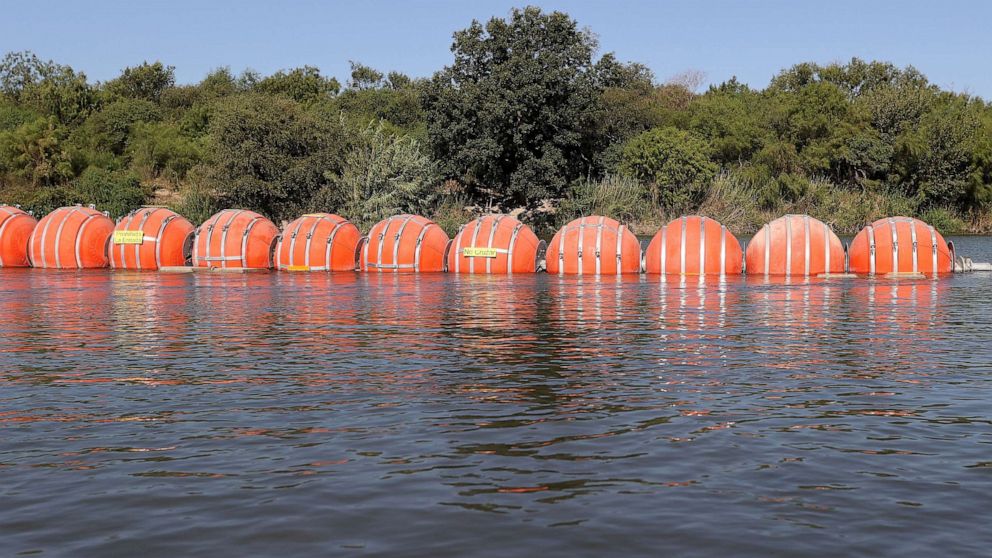


The Justice Department is likely to succeed on its claim that floating barriers Texas deployed in the Rio Grande to prevent migrants from crossing were illegally installed, a federal judge in Austin ruled -- adding the arguments used to justify the buoys are “unconvincing” and, in at least one instance, unconstitutional.
Judge David Alan Ezra ordered the Lonestar state to move its buoys on Wednesday and said the Justice Department is likely to prevail on its claim that Texas lacked proper authority to install them in the first place and that the state had employed "unconvincing" and conflicting rationale in doing so.
The ruling grants a preliminary injunction to the Department of Justice, which sued Texas for placing the buoys in the Rio Grande in July.
"Governor Abbott announced that he was not 'asking for permission' for Operation Lone Star, the anti-immigration program under which Texas constructed the floating barrier," Ezra wrote. "Unfortunately for Texas, permission is exactly what federal law requires before installing obstructions in the nation's navigable waters."
MORE: Trump may seek to have his Georgia election interference case removed to federal courtTexas Gov. Greg Abbott has said the state will appeal the ruling, calling it "incorrect."
Judge Ezra's order gave the state until Sept. 15 to coordinate with the Army Corps of Engineers to move the buoys -- but Thursday, a U.S. Appeals Court granted a temporary stay allowing Texas to keep the buoys in place -- at least for now.
"We will continue to utilize every strategy to secure the border, including deploying Texas National Guard soldiers and Department of Public Safety troopers and installing strategic barriers," Abbott said in a statement Wednesday. "Our battle to defend Texas' sovereign authority to protect lives from the chaos caused by President Biden's open border policies has only begun."
In court filings, Texas has said the buoy system was deployed as part of that strategy to protect against a surge of "[t]housands of aliens ... including members of cartels that traffic in people, weapons, and vast quantities of drugs like fentanyl."
MORE: Federal judge orders buoys in Rio Grande moved to Texas riverbank"By any account, this amounts to 'ent[ry] in a hostile manner.' And the State has the constitutional power to repel that invasion," the state said.
But the judge ruled Texas' "'invasion' defense" is a political question -- not a legal one -- and that even if there were an "invasion" at the Southern border, as they've claimed, then protecting American shores would be the province of the federal government, not Texas.
Ezra, appointed by President Ronald Reagan and serving since 1988, said there are "several constitutional provisions" which "assign the federal government—not states—the authority to recognize and respond to invasions," and "the political question doctrine bars consideration of Texas's 'invasion' defense."
"Texas's self defense argument is unconvincing," the judge wrote.
MORE: 2 bodies found in Rio Grande near US-Mexico border: OfficialsThough the Lonestar State has repeatedly asserted its sovereignty to defend the border, federal "power to prevent unauthorized obstacles in the nation's navigable waters trumps state policy preferences," the judge said.
The judge rejected not only Texas' claims of authority to install the 1,000-foot-long, four-foot-wide chain of interconnected buoys in the Rio Grande -- but also the way they attempted to characterize that buoy system.
Texas takes the "confusing stance" that the buoys can't be a "structure" (which, in navigable U.S. water, would require an Army Corps of Engineers permit) because buoys "aid navigation," the judge wrote, quoting the state's arguments.
But this is a "convenient" claim from Texas that "contradicts its own description," the judge wrote -- since the state had said the buoys were designed as a "physical barrier" created "to deter illegal crossing in hotspots along the Rio Grande."
"Texas strains credulity with its argument that the floating barrier is not permanent enough to constitute a structure," the judge wrote.
Questions also remain as to how the vast majority of Texas' buoy barriers wound up on Mexico's side of the river, the judge said.
In August, the Justice Department submitted a binational topographic survey, conducted in late July, which found that nearly 80 percent of the barrier was positioned in Mexican waters. A few days later, Texas was "observed seemingly 'repositioning the Floating Barrier' closer to the United States bank," a footnote in the judge's ruling says.
At a hearing, "testimony was elicited that the buoys were moved back into Texas waters. Testimony was also elicited that the buoys could not have drifted," the judge wrote. "But in a statement on August 21, 2023, Governor Abbott indicated that they had drifted."
"There is still some ambiguity as to whether 80% of the buoys ended up in Mexican waters by drifting or by being originally, incorrectly installed there," the judge wrote.